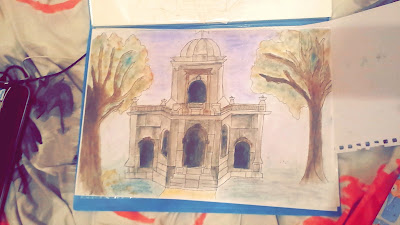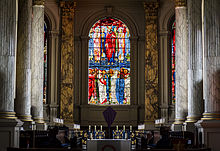St Philip's was designed by Thomas archer and constructed between 1711 and 1715. The tower was complete by 1725,
and the urns on the parapet were added in 1756. Archer had visited Rome and his design, in the Baroque style, is influenced by the churches of Borromini, being rather more Italianate than churches by Christopher Wren.
The rectangular hall church interior has aisles separated from the nave by fluted pillars of classical form with Tuscan capitals supporting an arcade surmounted by a heavily projecting cornice. Wooden galleries are stretched between the pillars in a manner typical of English Baroque churches.
Externally, the tall windows are interspaced by pilasters in low
relief, supporting a balustrade at roof level with an urn rising above
each pilaster. The western end is marked by a single tower which rises
in stages and is surmounted by a lead-covered dome and a delicate
lantern. The building is of brick and is faced with stone quarried on Archer's estate at Umberslade.
The chancel, featuring stained
glass by Edward Burne-Jones
The original shallow eastern apse was extended in 1884-8 by J. A. Chatwin into a much larger chancel,[1] articulated by strongly projecting Corinthian
columns. This bold design is made richer by the marbled surfaces of the
columns and pilasters, the gilding of capitals and cornice and the
ornately coffered ceiling. Chatwin also refaced the exterior of the
building because the stone from the original quarry was very soft.[1] The tower was refaced in 1958-59.
Edward Burne-Jones,
who was born in nearby Bennett's Hill and baptised in the church, added
to the enhancement of St Philips by the donation of several windows, of
which three are at the eastern end. The west window, also by
Burne-Jones, was dedicated in memory of Bishop Bowlby in 1897.[4]
Six of the monuments have heritage listings, including one commemorating two men who died during the construction of Birmingham Town Hall and a memorial to the victims of the Birmingham pub bombings. Thomas Stirling Lee's
statue of Bishop Charles Gore, vested in convocation robes with his
right hand raised in blessing, is located at the West entrance. A large Portland stone obelisk commemorates Frederick Gustavus Burnaby.
Besides Burnaby's bust, in relief, it carries only the word "Burnaby",
and the dated place names "Khiva 1875" and "Abu Klea 1885". These refer
to the Khanate of Khiva and Battle of Abu Klea, respectively; he was killed at the latter.[6] The obelisk was unveiled by Lord Charles Beresford on 13 November 1885.[7] Upon completion of the building, it was decided to prohibit monuments from being added to the interior.[4]






